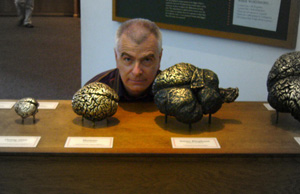Professor György Buzsáki
György Buzsáki, M.D., Ph.D., FAAAS is Board of Governors Professor, Center for Molecular and Behavioral Neuroscience, Rutgers University.
Gyuri’s main interest is how neuronal circuitries of the brain support its cognitive capacities. His goal is to provide rational, mechanistic explanations of cognitive functions at a descriptive level. In his view, the most promising area of cognitive faculties for scientific inquiry is memory, since it is a well-circumscribed term, can be studied in animals, and substantial knowledge has accumulated on the molecular mechanisms of synaptic plasticity.
The theoretical framework can be summarized as follows. Bringing anatomically-distributed populations of neurons together in time is a major function provided by network oscillations. Through their interconnectivity, GABAergic interneurons can maintain both localized and large-scale oscillations at various frequency ranges (theta, gamma, 200 Hz).
Networks of inhibitory interneurons within the forebrain impose coordinated oscillatory “contexts” for the “content” carried by networks of principal cells and provide the precise temporal structure necessary for ensembles of neurons to perform specific functions. The neocortico-hippocampal transfer of information and the modification process in neocortical circuitries by the hippocampal output take place in a temporally discontinuous manner.
Acquisition of information may happen very fast during the activated state of the hippocampus associated with theta/gamma oscillations. Intrahippocampal consolidation and the hippocampal-neocortical transfer of the stored representations are protracted and may be carried by discrete quanta of cooperative 200 Hz bursts during slow wave sleep. This general, two-stage framework of memory trace consolidation, is supported several experiments and computational models carried out by us and others. Most of his experimental investigations target one or several of the above issues.
Gyuri authored Rhythms of the Brain, and coauthored Interneurons of the Hippocampus, Hippocampal Network Dynamics Constrain the Time Lag between Pyramidal Cells across Modified Environments, Theta and Gamma Coordination of Hippocampal Networks during Waking and Rapid Eye Movement Sleep, Behavior-dependent short-term assembly dynamics in the medial prefrontal cortex, Gamma oscillations dynamically couple hippocampal CA3 and CA1 regions during memory task performance, and Neuronal Diversity in GABAergic Long-Range Projections from the Hippocampus.
Gyuri earned his M.D. at the University of Pecs, Hungary in 1974. He then did his postdoctoral work in Neuroscience at the University of Texas, San Antonio, TX and the University of Western Ontario, London, ON, Canada. He earned his Ph.D. in Neuroscience at the Academy of Sciences, Budapest, Hungary in 1984. He is a Fellow of the American Association for the Advancement of Science and an honorary member of the Hungarian Academy of Sciences, and he sits on the editorial boards of several leading neuroscience journals including Neuron, Reviews in Neuroscience, Behavioral Brain Research, and Hippocampus.
Watch Organization of neuronal assemblies in the hippocampus. Listen to Brain Science Podcast #31: Brain Rhythms with György Buzsáki. Read 10 Questions for György Buzsáki.
